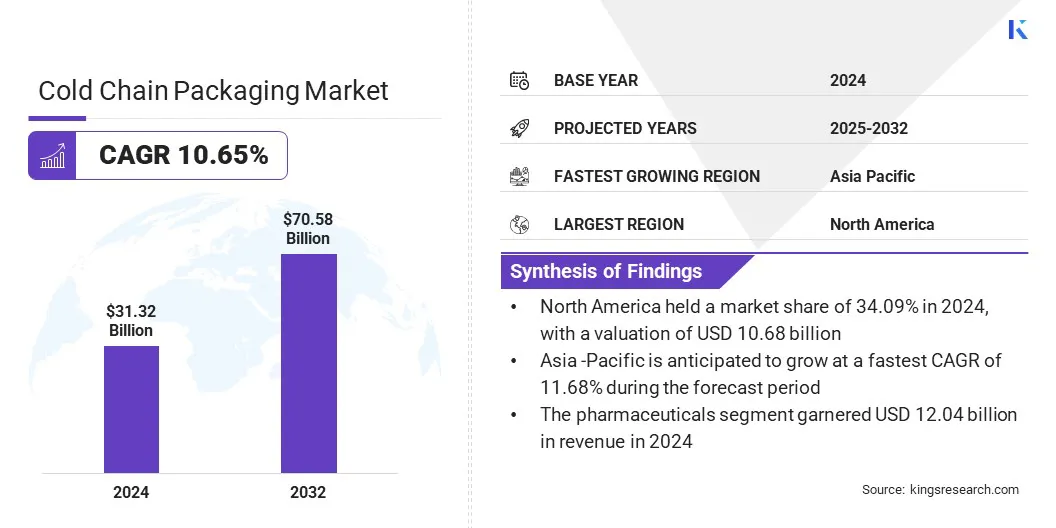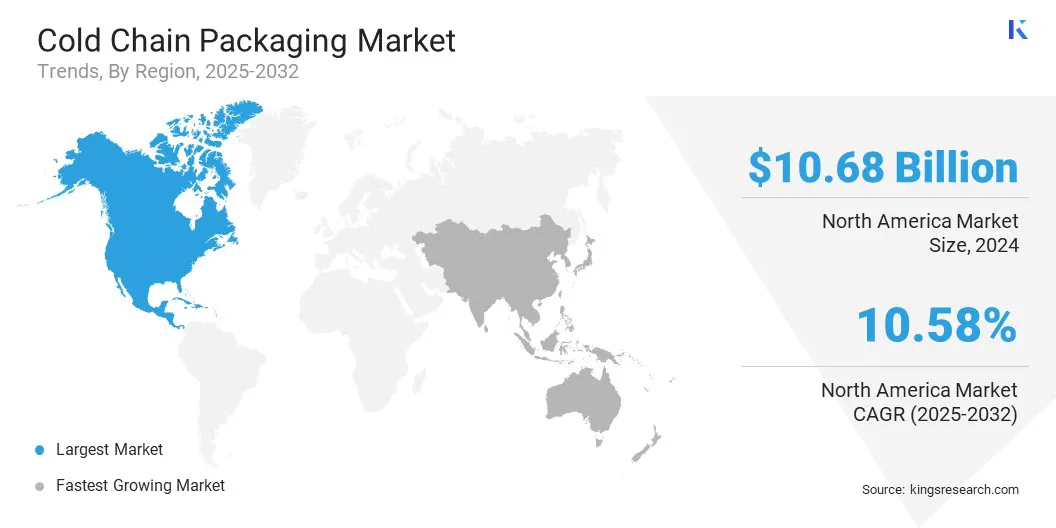Market Definition
Cold chain packaging is a specialized system designed to maintain stable temperature conditions for sensitive products such as pharmaceuticals, vaccines, biologics, and perishable food items during storage and transit.
It ensures product safety and quality by using insulated materials and temperature-controlling components to prevent exposure to temperature fluctuations.
Cold Chain Packaging Market Overview
The global cold chain packaging market size was valued at USD 31.32 billion in 2024 and is projected to grow from USD 34.60 billion in 2025 to USD 70.58 billion by 2032, exhibiting a CAGR of 10.65% during the forecast period.
The market is driven by the increasing demand for temperature-sensitive biopharmaceuticals such as vaccines and specialty drugs which are encouraging pharmaceutical companies to adopt advanced cold chain packaging that ensures stability and compliance during storage and transit.
The market is further propelled by the rapid expansion of e-commerce in perishable goods, as consumers are increasingly purchasing groceries and meal kits online.
Key Market Highlights:
- The cold chain packaging industry size was valued at USD 31.32 billion in 2024.
- The market is projected to grow at a CAGR of 10.65% from 2025 to 2032.
- North America held a market share of 34.09% in 2024, with a valuation of USD 10.68 billion.
- The expanded polystyrene (EPS) segment garnered USD 11.34 billion in revenue in 2024.
- The insulated pallet shippers segment is expected to reach USD 19.84 billion by 2032.
- The pharmaceuticals segment is anticipated to witness the fastest CAGR of 10.67% over the forecast period.
- Asia Pacific is anticipated to grow at a CAGR of 11.68% through the projection period.
Major companies operating in the cold chain packaging market are Cold Chain Technologies, Sonoco ThermoSafe, Cryopak, Peli BioThermal LLC, Csafe, Intelsius, Sofrigam, TemperPack, Sealed Air, Siddhi Cold Chain, SF Express, NICHIREI CORPORATION, Emball'Iso and Insulated Products Corporation.

Additionally, the growing biopharmaceutical sector is increasingly depending on cold chain packaging to ensure the safe handling of temperature-sensitive products such as monoclonal antibodies, cell and gene therapies, and mRNA-based vaccines.
These biologics are highly sensitive to temperature fluctuations and can lose efficacy if not stored and transported under strict thermal conditions, thereby driving the demand for advanced, validated packaging solutions that offer precise temperature control.
Market Driver
Expansion of E-commerce in Perishables
The expansion of e-commerce in perishables is significantly increasing the demand for reliable cold chain packaging solutions. Consumers are increasingly preferring online platforms for groceries, meal kits, and specialty foods, due to which maintaining the product freshness during transit has become essential.
Market players in the market are investing in insulated packaging that ensures temperature stability across last-mile deliveries. This shift is prompting packaging providers to develop innovative, sustainable, and performance-driven solutions that protect temperature-sensitive items, enhance customer satisfaction and minimize the risk of spoilage.
- According to the Government of Canada, in the U.S., online grocery sales accounted for 11.8% of total grocery sales in 2023, growing at over 26.4% CAGR since 2019.
Market Challenge
High Cost of Cold Chain Infrastructure
The high cost of cold chain infrastructure remains a major challenge in the cold chain packaging market, particularly for emerging markets and small to mid-sized enterprises. Setting up temperature-controlled storage, transportation, and monitoring systems demands considerable capital investment along with significant ongoing operational expenditures.
Additionally, maintaining consistent temperatures across complex and extended supply chains increases both energy consumption and labor requirements, further compounding operational costs and logistical challenges.
To address these challenges, companies are investing in reusable packaging systems and modular cold storage units to reduce long-term operational expenses. They are leveraging digital monitoring technologies to improve efficiency and minimize waste.
Additionally, automation and AI-driven route optimization are being integrated to streamline logistics and cut fuel and labor costs. They are adopting region-specific solutions that optimize transport routes and storage capacity, enabling more cost-effective operations while maintaining product safety and compliance across temperature-sensitive supply chains.
Market Trend
Adoption of Sustainable and Recyclable Materials
The shift toward sustainable and recyclable materials is a prominent trend in the market, fueled by stricter environmental regulations and a growing focus on achieving industry-wide sustainability targets.
Market players in the market are shifting from traditional materials such as expanded polystyrene and adopting fiber-based plastic-free alternatives that offer comparable thermal performance. These eco-friendly solutions reduce landfill waste and support circular economy initiatives.
Cold chain packaging providers are integrating recyclable components, meeting functional requirements, supporting regulatory compliance, and advancing sustainability targets.
- In January 2025, DS Smith launched TailorTemp, a recyclable temperature-controlled packaging solution for the pharmaceutical industry. The solution uses corrugated cardboard insulating inserts and a plastic-free outer case, offering up to 36 hours of cooling as a sustainable alternative to EPS.
Cold Chain Packaging Market Report Snapshot
|
Segmentation
|
Details
|
|
By Material
|
Expanded, Polystyrene Foam (PUR), Paper & Paperboard, Others
|
|
By Product
|
Insulated Pallet Shippers, Insulated Containers, Vacuum Insulated Panels, Gel Packs, Others
|
|
By End Use Industry
|
Pharmaceuticals, Food
|
|
By Region
|
North America: U.S., Canada, Mexico
|
|
Europe: France, UK, Spain, Germany, Italy, Russia, Rest of Europe
|
|
Asia-Pacific: China, Japan, India, Australia, ASEAN, South Korea, Rest of Asia-Pacific
|
|
Middle East & Africa: Turkey, U.A.E., Saudi Arabia, South Africa, Rest of Middle East & Africa
|
|
South America: Brazil, Argentina, Rest of South America
|
Market Segmentation:
- By Material (Expanded Polystyrene (EPS), Polyurethane Rigid Foam (PUR), Paper & Paperboard, and Others): The expanded polystyrene (EPS) segment earned USD 11.34 billion in 2024 due to its excellent insulation properties, lightweight nature, and cost-effectiveness for cold chain applications.
- By Product (Insulated Pallet Shippers, Insulated Containers, Vacuum Insulated Panels, and Gel Packs): The insulated pallet shippers segment held 28.08% of the market in 2024, due to their ability to transport large volumes while maintaining consistent temperature control.
- By End Use Industry (Pharmaceuticals, Food, and Industrial): The pharmaceuticals segment is projected to reach USD 27.17 billion by 2032, owing to rising demand for biologics, vaccines, and temperature-sensitive drugs.
Cold Chain Packaging Market Regional Analysis
Based on region, the global market has been classified into North America, Europe, Asia Pacific, Middle East & Africa, and South America.

North America cold chain packaging market accounted for a share of 34.09% in 2024, with a valuation of USD 10.68 billion. This dominance is driven by a well-established cold chain infrastructure, increasing demand for temperature-sensitive pharmaceuticals and perishable food, and widespread adoption of advanced sustainable packaging technologies.
Moreover, the region’s focus on reducing environmental impact and improving supply chain efficiency is driving the uptake of eco-friendly solutions. Additionally, the presence of key market players investing in innovation and facility expansion is further driving market growth across the region.
- In October 2024, Nordic Cold Chain Solutions acquired Minus Works Inc. and expanded its facilities across Pennsylvania, Nevada, and New York. Through this acquisition, Nordic Cold Chain Solutions aims to enhance operational efficiency and lower carbon emissions by integrating compostable gel packs and a proprietary freezing process.
The Asia Pacific is set to grow at a CAGR of 11.68% over the forecast period. This growth is attributed to rising demand for temperature-sensitive pharmaceutical and biologic products in the region.
Increasing investments by market players in advanced thermal packaging technologies are supporting the need for efficient and compliant supply chains that ensure product integrity and regulatory adherence during transit.
Moreover, growing government focus on healthcare infrastructure and the expansion of international trade in perishable goods are enhancing cold chain capabilities and driving demand for reliable packaging solutions.
Additionally, strategic acquisitions by key players to strengthen regional presence are improving access to high-performance cold chain solutions, further accelerating market expansion.
- In March 2025, Cold Chain Technologies acquired Global Cold Chain Solutions to expand its presence in Asia Pacific, focusing on Australia and India. This acquisition enhances CCT’s global supply network and introduces high-performance thermal packaging technologies, supporting rising demand for temperature-sensitive pharmaceutical logistics in the region.
Regulatory Frameworks
- In the U.S., the Food and Drug Administration (FDA) regulates cold chain packaging for pharmaceuticals and perishable foods under CGMP, GDP, and FSMA guidelines, overseeing temperature validation, monitoring systems, and recordkeeping to ensure product safety and integrity.
- In China, the National Medical Products Administration (NMPA) governs cold chain requirements for drugs, vaccines, and biologics, enforcing GDP principles and inspecting storage and transport facilities. It oversees temperature control standards, packaging validation, and quality checks at customs.
- In India, the Central Drugs Standard Control Organization (CDSCO) mandates cold chain compliance for vaccines, insulin, and biologics under the Drugs and Cosmetics Rules, overseeing packaging qualification, distribution protocols, and facility inspections. It ensures temperature integrity from manufacturer to point of care.
- In the UK, the Medicines and Healthcare Products Regulatory Agency (MHRA) enforces GDP guidelines for temperature‑sensitive pharmaceuticals, overseeing packaging qualification, temperature monitoring, and batch traceability throughout the supply chain. It ensures compliance with post‑Brexit UK standards and collaborates with the FSA on food logistics.
Competitive Landscape
Major players in the cold chain packaging market are acquiring small to mid-sized companies across key regions to expand geographic reach and scale up production capacity. They are introducing reusable, passive packaging systems to reduce environmental impact and align with evolving sustainability goals.
Moreover, they are establishing localized service hubs across pharmaceutical manufacturing clusters and food distribution networks to improve service responsiveness.
Additionally, they are integrating digital tracking and real-time temperature monitoring technologies into packaging solutions to strengthen compliance and ensure the safe transport of biologics and other high-value pharmaceuticals.
- In October 2024, Cold Chain Technologies acquired Tower Cold Chain to strengthen its global presence and expand its portfolio of reusable temperature-controlled packaging solutions. The acquisition adds over 20 service hubs worldwide and brings advanced capabilities in thermal engineering and digital monitoring, reinforcing CCT’s focus on sustainable, high-performance packaging for the life sciences sector.
Key Companies in Cold Chain Packaging Market:
- Cold Chain Technologies
- Sonoco ThermoSafe
- Cryopak
- Peli BioThermal LLC
- Csafe
- Intelsius
- Peli BioThermal LLC
- Sofrigam
- TemperPack
- Sealed Air
- Siddhi Cold Chain
- SF Express
- NICHIREI CORPORATION
- Emball'Iso
- Insulated Products Corporation.
Recent Developments (M&A/Product Launch)
- In April 2025, Cold Chain Technologies launched the CCT Tower Elite, a reusable universal temperature-controlled pallet shipper. Introduced at LogiPharma 2025, the 1600L solution supports both Euro and US pallets, offering the lightest design in its class to enhance cost-efficiency and handling while ensuring reliable global transport of temperature-sensitive pharmaceuticals.
- In January 2025, UPS acquired Germany-based Frigo-Trans and BPL to expand its healthcare cold-chain logistics network across Europe. The acquisition enhances UPS Healthcare’s end-to-end capabilities, including cryogenic to ambient temperature-controlled warehousing and time-critical freight forwarding, enabling improved product security, reduced losses, and increased visibility in pharmaceutical cold chain deliveries.
the


